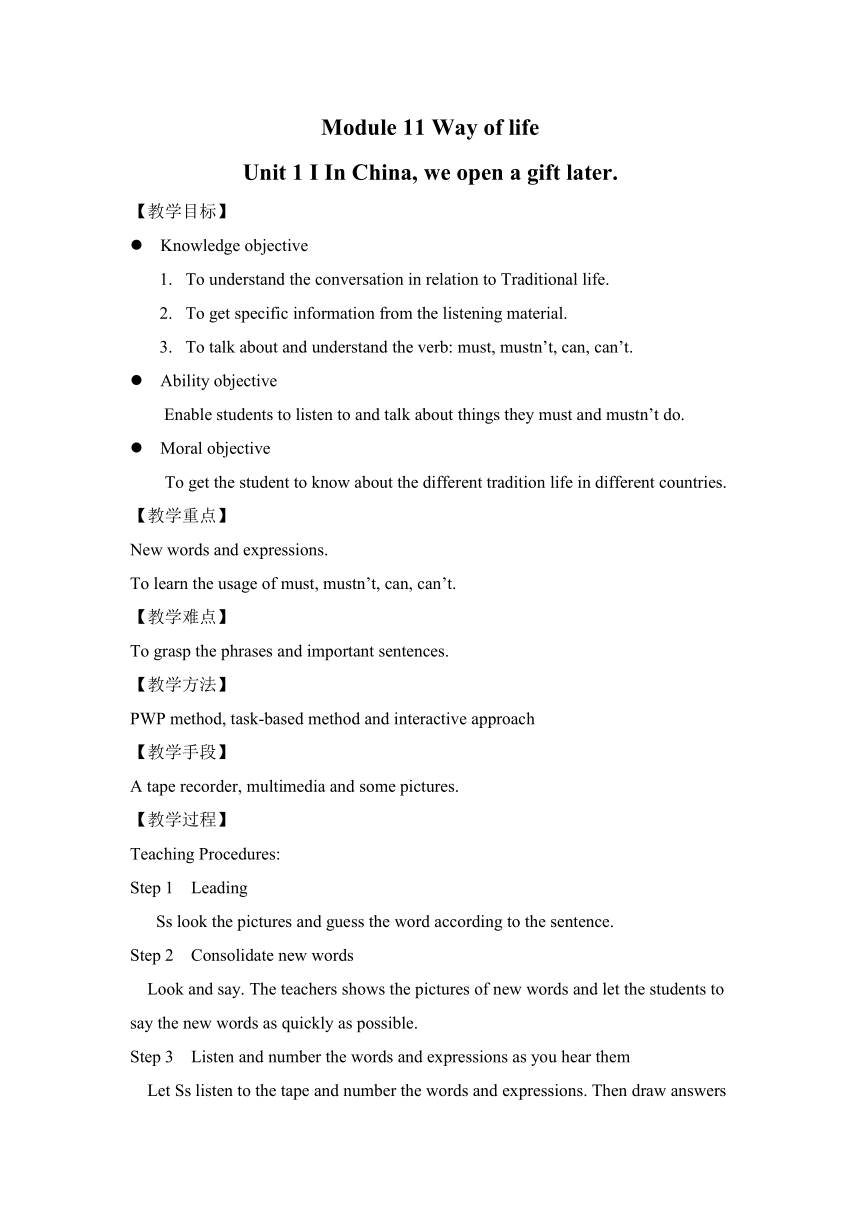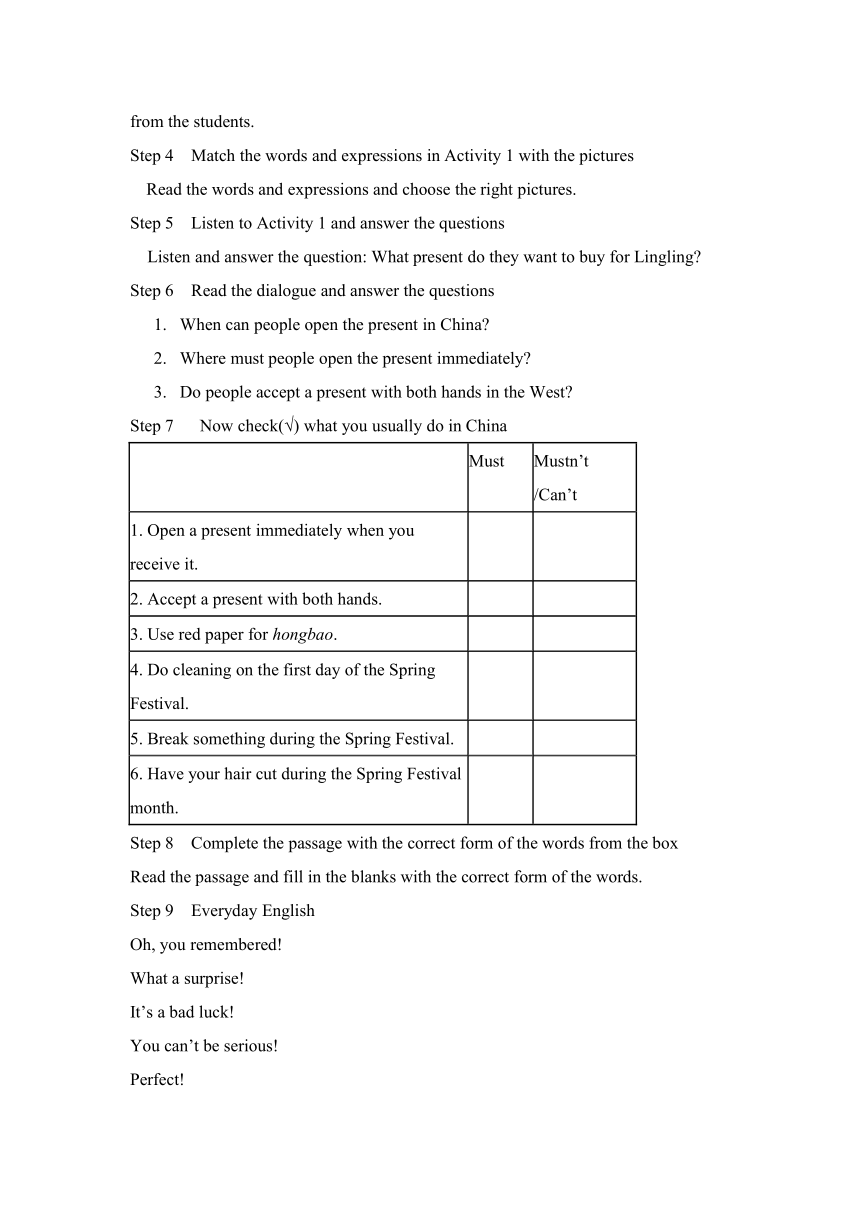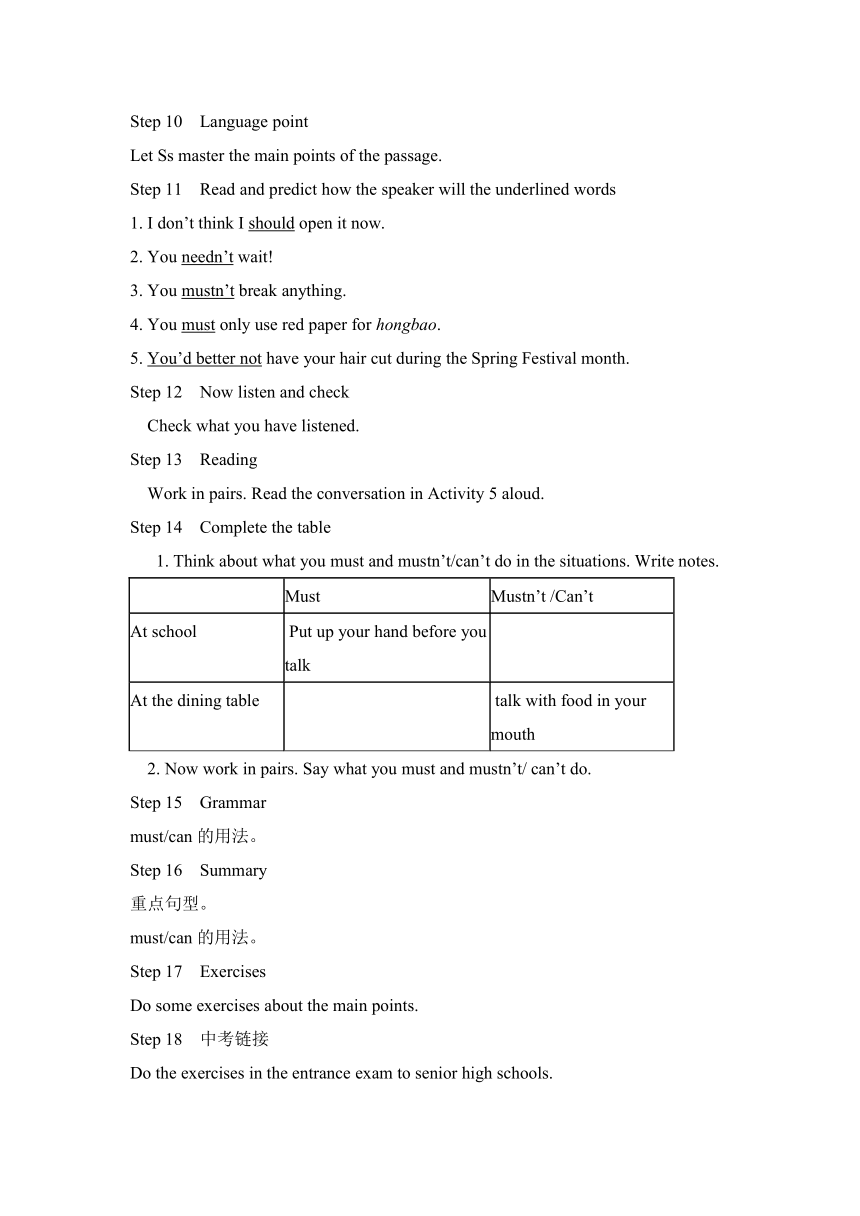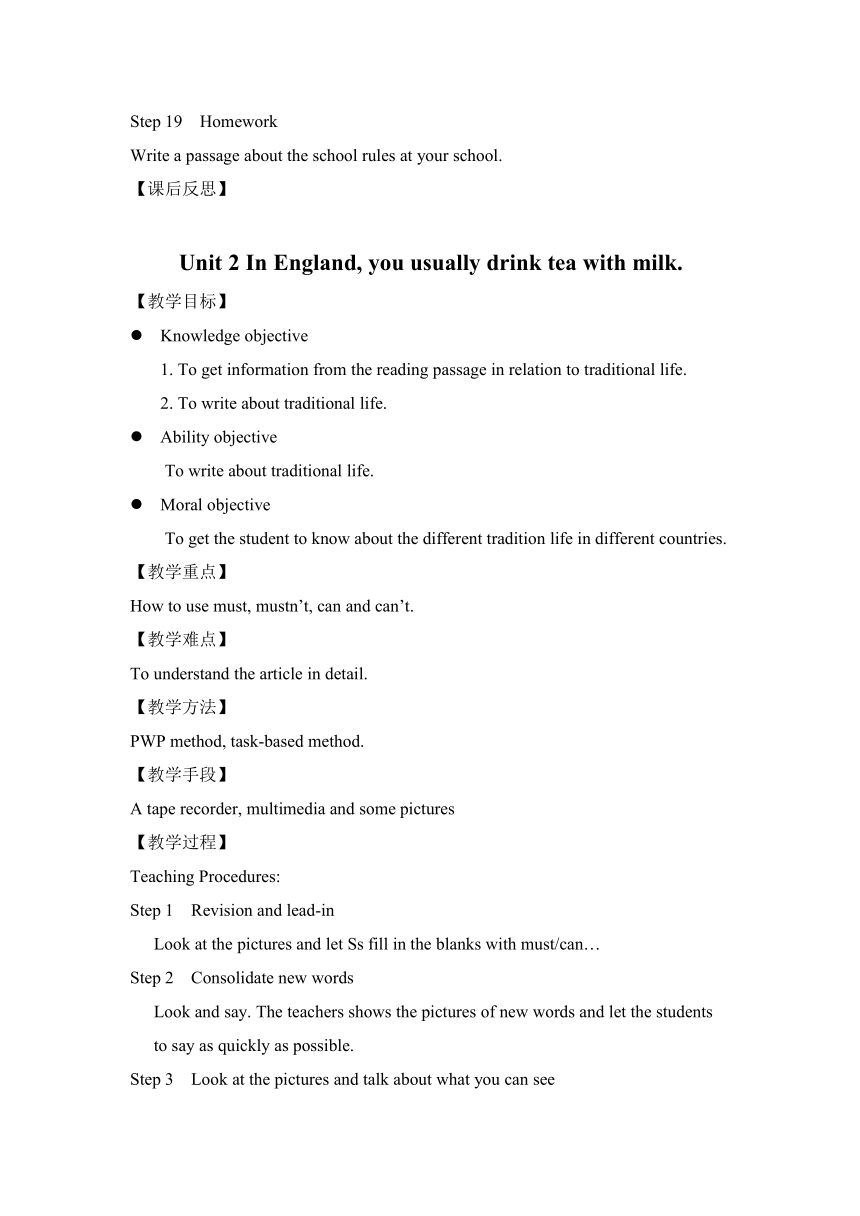Module 11 Way of life.模块教案
文档属性
| 名称 | Module 11 Way of life.模块教案 |  | |
| 格式 | zip | ||
| 文件大小 | 19.2KB | ||
| 资源类型 | 教案 | ||
| 版本资源 | 外研版 | ||
| 科目 | 英语 | ||
| 更新时间 | 2013-09-24 18:56:06 | ||
图片预览




文档简介
Module 11 Way of life
Unit 1 I In China, we open a gift later.
【教学目标】
Knowledge objective
To understand the conversation in relation to Traditional life.
To get specific information from the listening material.
To talk about and understand the verb: must, mustn’t, can, can’t.
Ability objective
Enable students to listen to and talk about things they must and mustn’t do.
Moral objective
To get the student to know about the different tradition life in different countries.
【教学重点】
New words and expressions.
To learn the usage of must, mustn’t, can, can’t.
【教学难点】
To grasp the phrases and important sentences.
【教学方法】
PWP method, task-based method and interactive approach
【教学手段】
A tape recorder, multimedia and some pictures.
【教学过程】
Teaching Procedures:
Step 1 Leading
Ss look the pictures and guess the word according to the sentence.
Step 2 Consolidate new words
Look and say. The teachers shows the pictures of new words and let the students to say the new words as quickly as possible.
Step 3 Listen and number the words and expressions as you hear them
Let Ss listen to the tape and number the words and expressions. Then draw answers from the students.
Step 4 Match the words and expressions in Activity 1 with the pictures
Read the words and expressions and choose the right pictures.
Step 5 Listen to Activity 1 and answer the questions
Listen and answer the question: What present do they want to buy for Lingling
Step 6 Read the dialogue and answer the questions
When can people open the present in China
Where must people open the present immediately
Do people accept a present with both hands in the West
Step 7 Now check(√) what you usually do in China
Must Mustn’t /Can’t
1. Open a present immediately when you receive it.
2. Accept a present with both hands.
3. Use red paper for hongbao.
4. Do cleaning on the first day of the Spring Festival.
5. Break something during the Spring Festival.
6. Have your hair cut during the Spring Festival month.
Step 8 Complete the passage with the correct form of the words from the box
Read the passage and fill in the blanks with the correct form of the words.
Step 9 Everyday English
Oh, you remembered!
What a surprise!
It’s a bad luck!
You can’t be serious!
Perfect!
Step 10 Language point
Let Ss master the main points of the passage.
Step 11 Read and predict how the speaker will the underlined words
1. I don’t think I should open it now.
2. You needn’t wait!
3. You mustn’t break anything.
4. You must only use red paper for hongbao.
5. You’d better not have your hair cut during the Spring Festival month.
Step 12 Now listen and check
Check what you have listened.
Step 13 Reading
Work in pairs. Read the conversation in Activity 5 aloud.
Step 14 Complete the table
1. Think about what you must and mustn’t/can’t do in the situations. Write notes.
Must Mustn’t /Can’t
At school Put up your hand before you talk
At the dining table talk with food in your mouth
2. Now work in pairs. Say what you must and mustn’t/ can’t do.
Step 15 Grammar
must/can的用法。
Step 16 Summary
重点句型。
must/can的用法。
Step 17 Exercises
Do some exercises about the main points.
Step 18 中考链接
Do the exercises in the entrance exam to senior high schools.
Step 19 Homework
Write a passage about the school rules at your school.
【课后反思】
Unit 2 In England, you usually drink tea with milk.
【教学目标】
Knowledge objective
1. To get information from the reading passage in relation to traditional life.
2. To write about traditional life.
Ability objective
To write about traditional life.
Moral objective
To get the student to know about the different tradition life in different countries.
【教学重点】
How to use must, mustn’t, can and can’t.
【教学难点】
To understand the article in detail.
【教学方法】
PWP method, task-based method.
【教学手段】
A tape recorder, multimedia and some pictures
【教学过程】
Teaching Procedures:
Step 1 Revision and lead-in
Look at the pictures and let Ss fill in the blanks with must/can…
Step 2 Consolidate new words
Look and say. The teachers shows the pictures of new words and let the students to say as quickly as possible.
Step 3 Look at the pictures and talk about what you can see
Look at the pictures and talk about in pairs.
Step 4 Listening
Listen to the passage and answer the questions.
When do people have afternoon tea in Britain
What is the traditional food in England
Step 5 Read and say
Read My experience in England. Which sentences describe what you can see in the pictures in Activities 1
Step 6 Choose the correct answers
First let the Ss read the passage carefully and then check the answers according the passage.
Step 7 Write full answers to the questions. Use the words from the box.
1. What did Wang Hui notice when he was in England
2. What is one example of the English way of life
3. What do you eat for afternoon tea
4. How can you eat fish and chips
5. What do people do when they wait for the bus
Step 8 Language points
Let Ss master the main points of the passage.
Step 9 Answer the questions about way of life in your home town
1. What do you do when you meet people for the first time
2. What must you say when you talk to older people
3. What food and drink do you give to visitors when they come to your home
4. What do you eat during the Spring Festival
Step 10 Writing
Write a passage about ways of life in your home town. Use your answers in Activities 5 to help you.
Step 11 Grammar
To master the usage of need/had better.
Step 12 Summary
Let Ss talk about what they have learnt in class.
Step 13 Exercises
Let the students practice the main points in Unit 2.
Step 14 中考链接
Do some exercises from the entrance exam to senior high schools.
Step 15 Homework
Write a passage to describe what you should do at the bus stop.
【课后反思】
Unit 3 Language in use
【教学目标】
To use the points in Units 1 and 2.
To make Ss learn about the traditional life and how to respect the traditional life in other countries.
【教学重点】
To master the word, the numbers and the article.
【教学难点】
The using of must/ can/ need/ had better.
【教学方法】
PWP method, Formal and interactive practice
【教学手段】
A tape recorder, multimedia and some pictures
【教学过程】
Teaching Procedures:
Step 1 Revision and lead-in
Look at the pictures and guess the meaning.
Step 2 Language practice
To master the structure of the grammar by filling the blanks.
Step 3 Complete the sentences with can or can’t
Read the sentences carefully.
Fill in the blanks with can/can’t.
Step 4 Learning to learn
To learn about how to know about English traditions.
Step 5 Complete the sentences with must or must not
Fill in the blanks with must/must not after Ss read the sentences carefully.
Step 6 Underline the correct words
1. Read the passage carefully.
2. Then underline the right words
Step 7 Listening
Listen to a teenager talking about his life and check the things he must and mustn’t do.
Listen again and answer the question: What two things does he say he can do
Step 8 Write some things you can, must and must not do at home
Look at the pictures and write down what you can, must and mustn’t do at home.
I can … I must … I must not …
Step 9 Make a dialogue
To tell each other three things you must do at home and three things you mustn’t do in pairs.
To tell if your home rules different or the same
Step 10 Complete the passage with the words and expressions in the box
Read the sentences and understand the meanings.
Choose the correct expressions.
Step 11 Play a class game
To choose a word or an expression from the box and describe it to the class. Then the class guesses what it is.
Step 12 Around the world
To know about the traditional presents.
Step 13 Writing
1. To write some advice for foreign visitors to a Chinese family.
Think about the following questions:
What must they wear
What mustn’t they talk about
What can’t they do
What presents can they bring
When must you arrive
2. Work in groups. Show the advice you wrote in Activity 9 to your group members. Choose the two best pieces of advices.
3. Show the advice your group chose in Activity 10 to the whole class. Put the pieces of advice together to form your class advice.
4. Send your advice to your foreign friends or paste it on your class blog.
Step 14 Exercises
Do some exercises and draw the answers from the Ss.
Step 15 中考链接
Do some exercises from the entrance exam to senior high schools.
Step 16 Summary
Let the students say what they have learnt in class by themselves.
Step 17 Homework
请为学校新建的图书馆制定规章制度,写一篇60词左右的短文。
【课后反思】
Unit 1 I In China, we open a gift later.
【教学目标】
Knowledge objective
To understand the conversation in relation to Traditional life.
To get specific information from the listening material.
To talk about and understand the verb: must, mustn’t, can, can’t.
Ability objective
Enable students to listen to and talk about things they must and mustn’t do.
Moral objective
To get the student to know about the different tradition life in different countries.
【教学重点】
New words and expressions.
To learn the usage of must, mustn’t, can, can’t.
【教学难点】
To grasp the phrases and important sentences.
【教学方法】
PWP method, task-based method and interactive approach
【教学手段】
A tape recorder, multimedia and some pictures.
【教学过程】
Teaching Procedures:
Step 1 Leading
Ss look the pictures and guess the word according to the sentence.
Step 2 Consolidate new words
Look and say. The teachers shows the pictures of new words and let the students to say the new words as quickly as possible.
Step 3 Listen and number the words and expressions as you hear them
Let Ss listen to the tape and number the words and expressions. Then draw answers from the students.
Step 4 Match the words and expressions in Activity 1 with the pictures
Read the words and expressions and choose the right pictures.
Step 5 Listen to Activity 1 and answer the questions
Listen and answer the question: What present do they want to buy for Lingling
Step 6 Read the dialogue and answer the questions
When can people open the present in China
Where must people open the present immediately
Do people accept a present with both hands in the West
Step 7 Now check(√) what you usually do in China
Must Mustn’t /Can’t
1. Open a present immediately when you receive it.
2. Accept a present with both hands.
3. Use red paper for hongbao.
4. Do cleaning on the first day of the Spring Festival.
5. Break something during the Spring Festival.
6. Have your hair cut during the Spring Festival month.
Step 8 Complete the passage with the correct form of the words from the box
Read the passage and fill in the blanks with the correct form of the words.
Step 9 Everyday English
Oh, you remembered!
What a surprise!
It’s a bad luck!
You can’t be serious!
Perfect!
Step 10 Language point
Let Ss master the main points of the passage.
Step 11 Read and predict how the speaker will the underlined words
1. I don’t think I should open it now.
2. You needn’t wait!
3. You mustn’t break anything.
4. You must only use red paper for hongbao.
5. You’d better not have your hair cut during the Spring Festival month.
Step 12 Now listen and check
Check what you have listened.
Step 13 Reading
Work in pairs. Read the conversation in Activity 5 aloud.
Step 14 Complete the table
1. Think about what you must and mustn’t/can’t do in the situations. Write notes.
Must Mustn’t /Can’t
At school Put up your hand before you talk
At the dining table talk with food in your mouth
2. Now work in pairs. Say what you must and mustn’t/ can’t do.
Step 15 Grammar
must/can的用法。
Step 16 Summary
重点句型。
must/can的用法。
Step 17 Exercises
Do some exercises about the main points.
Step 18 中考链接
Do the exercises in the entrance exam to senior high schools.
Step 19 Homework
Write a passage about the school rules at your school.
【课后反思】
Unit 2 In England, you usually drink tea with milk.
【教学目标】
Knowledge objective
1. To get information from the reading passage in relation to traditional life.
2. To write about traditional life.
Ability objective
To write about traditional life.
Moral objective
To get the student to know about the different tradition life in different countries.
【教学重点】
How to use must, mustn’t, can and can’t.
【教学难点】
To understand the article in detail.
【教学方法】
PWP method, task-based method.
【教学手段】
A tape recorder, multimedia and some pictures
【教学过程】
Teaching Procedures:
Step 1 Revision and lead-in
Look at the pictures and let Ss fill in the blanks with must/can…
Step 2 Consolidate new words
Look and say. The teachers shows the pictures of new words and let the students to say as quickly as possible.
Step 3 Look at the pictures and talk about what you can see
Look at the pictures and talk about in pairs.
Step 4 Listening
Listen to the passage and answer the questions.
When do people have afternoon tea in Britain
What is the traditional food in England
Step 5 Read and say
Read My experience in England. Which sentences describe what you can see in the pictures in Activities 1
Step 6 Choose the correct answers
First let the Ss read the passage carefully and then check the answers according the passage.
Step 7 Write full answers to the questions. Use the words from the box.
1. What did Wang Hui notice when he was in England
2. What is one example of the English way of life
3. What do you eat for afternoon tea
4. How can you eat fish and chips
5. What do people do when they wait for the bus
Step 8 Language points
Let Ss master the main points of the passage.
Step 9 Answer the questions about way of life in your home town
1. What do you do when you meet people for the first time
2. What must you say when you talk to older people
3. What food and drink do you give to visitors when they come to your home
4. What do you eat during the Spring Festival
Step 10 Writing
Write a passage about ways of life in your home town. Use your answers in Activities 5 to help you.
Step 11 Grammar
To master the usage of need/had better.
Step 12 Summary
Let Ss talk about what they have learnt in class.
Step 13 Exercises
Let the students practice the main points in Unit 2.
Step 14 中考链接
Do some exercises from the entrance exam to senior high schools.
Step 15 Homework
Write a passage to describe what you should do at the bus stop.
【课后反思】
Unit 3 Language in use
【教学目标】
To use the points in Units 1 and 2.
To make Ss learn about the traditional life and how to respect the traditional life in other countries.
【教学重点】
To master the word, the numbers and the article.
【教学难点】
The using of must/ can/ need/ had better.
【教学方法】
PWP method, Formal and interactive practice
【教学手段】
A tape recorder, multimedia and some pictures
【教学过程】
Teaching Procedures:
Step 1 Revision and lead-in
Look at the pictures and guess the meaning.
Step 2 Language practice
To master the structure of the grammar by filling the blanks.
Step 3 Complete the sentences with can or can’t
Read the sentences carefully.
Fill in the blanks with can/can’t.
Step 4 Learning to learn
To learn about how to know about English traditions.
Step 5 Complete the sentences with must or must not
Fill in the blanks with must/must not after Ss read the sentences carefully.
Step 6 Underline the correct words
1. Read the passage carefully.
2. Then underline the right words
Step 7 Listening
Listen to a teenager talking about his life and check the things he must and mustn’t do.
Listen again and answer the question: What two things does he say he can do
Step 8 Write some things you can, must and must not do at home
Look at the pictures and write down what you can, must and mustn’t do at home.
I can … I must … I must not …
Step 9 Make a dialogue
To tell each other three things you must do at home and three things you mustn’t do in pairs.
To tell if your home rules different or the same
Step 10 Complete the passage with the words and expressions in the box
Read the sentences and understand the meanings.
Choose the correct expressions.
Step 11 Play a class game
To choose a word or an expression from the box and describe it to the class. Then the class guesses what it is.
Step 12 Around the world
To know about the traditional presents.
Step 13 Writing
1. To write some advice for foreign visitors to a Chinese family.
Think about the following questions:
What must they wear
What mustn’t they talk about
What can’t they do
What presents can they bring
When must you arrive
2. Work in groups. Show the advice you wrote in Activity 9 to your group members. Choose the two best pieces of advices.
3. Show the advice your group chose in Activity 10 to the whole class. Put the pieces of advice together to form your class advice.
4. Send your advice to your foreign friends or paste it on your class blog.
Step 14 Exercises
Do some exercises and draw the answers from the Ss.
Step 15 中考链接
Do some exercises from the entrance exam to senior high schools.
Step 16 Summary
Let the students say what they have learnt in class by themselves.
Step 17 Homework
请为学校新建的图书馆制定规章制度,写一篇60词左右的短文。
【课后反思】
同课章节目录
- Module 1 How to learn English
- Unit 1 Let's try to speak English as much as possi
- Unit 2 You should smile at her.
- Unit 3 Language in use .
- Module 2 My home town and my country
- Unit 1 It's taller than many other buildings.
- Unit 2 Cambridge is a beautiful city in the east o
- Unit 3 Language in use .
- Module 3 Sports.
- Unit 1 Nothing is more exciting than playing tenni
- Unit 2 This year we training more carefully.
- Unit 3 Language in use .
- Module 4 Planes, ships and trains .
- Unit 1 He lives the farthest from school.
- Unit 2 What is the best way to travel.
- Unit 3 Language in use .
- Module 5 Lao She Teahouse.
- Unit 1 I wanted to see the Beijing Opera.
- Unit 2 It descibes the changes in Chinese society.
- Unit 3 Language in use .
- Module 6 Animals in danger.
- Unit 1 It allows people to get closer to them .
- Unit 2 The WWF is working hard to save them all.
- Unit 3 Language in use .
- Revision module A
- Module 7 A famous story
- Unit 1 Alice was sitting with her sister by the ri
- Unit 2 She was thinking about her cat.
- Unit 3 Language in use .
- Module 8 Accidents
- Unit 1 While the car were changing to red, a car s
- Unit 2 I was trying to pick it up when it bite me
- Unit 3 Language in use .
- Module 9 Population
- Unit 1 The population of China is about 1.37 billi
- Unit 2 Arnwick was a city with 200,000 people.
- Unit 3 Language in use .
- Module 10 The weathe
- Unit 1 It might snow.
- Unit 2 The weather is fine all year round.
- Unit 3 Language in use .
- Module 11 Way of life
- Unit 1 In China ,we open a gift later.
- Unit 2 In England, you usually drink tea with milk
- Unit 3 Language in use .
- Module 12 Help
- Unit 1 What should we do before help arrives?
- Unit 2 Stay away from windows and heavy furniture.
- Unit 3 Language in use .
- Revision module B
